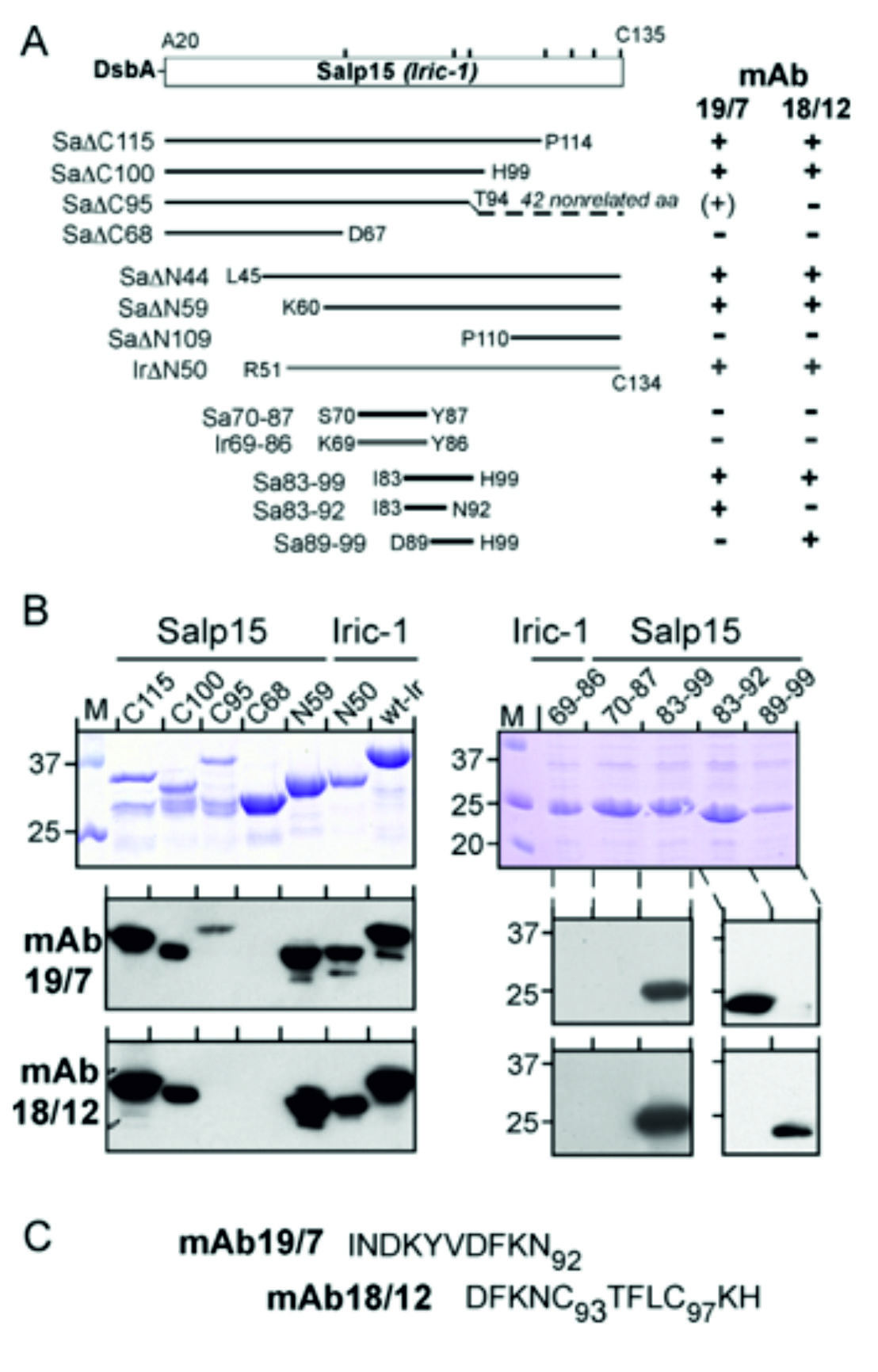murine MAb against tick saliva protein of 15kDa (Salp15) of Ixodes ricinus, clone 19/7.4
Description
Ticks are vectors for various, including pathogenic, microbes. Tick saliva contains multiple anti-host defense factors that enable ticks their blood meals yet also facilitate microbe transmission. Lyme disease-causing borreliae profit specifically from the broadly conserved tick histamine release factor (tHRF), and from cysteine-rich glycoproteins represented by Salp15 from Ixodes scapularis and Iric-1 from Ixodes ricinus ticks which they recruit to their outer surface protein C (OspC) as a protective coat against antibody-mediated killing. Salp15 is a secreted, immunosuppressive protein that binds to CD4 on murine T cells and to DC-SIGN on dendritic cells, compromising IL2 production and thus T cell proliferation.
Properties
The monoclonal antibody ADG0196L (19/7.4) is a murine monoclonal antibody, subclass IgG2a recognizing saliva protein Salp15 of Ixodes scapularis. Mice were immunized with rec. Salp15. The antibody has been purified from cell culture supernatant using Protein G affinity chromatography.
Presentation
Screw capped vial containing 1 mg of purified antibody in PBS pH 7.4. The IgG concentration is given on the vial label. Spin the vial briefly before opening.
Storage and Stability
Store the antibody at 2°-8°C. For long-term storage the antibody should be aliquoted and stored at –20°C or colder. It is recommended to avoid freeze-thaw cycles.
Applications
ELISA
The antibody can be used as capture antibody in ELISAs. An antibody concentration of 1-10 µg/ml is recommended.
Westernblot
The antibody is suitable for Western blot analysis, detecting native and recombinant Salp15 following SDS-PAGE under reducing conditions. A primary antibody concentration of 1-10 µg/mL is recommended.
Immunocytochemistry
The antibody can be used for immune-cytochemistry.

Mapping the epitopes of mAbs 19/7.4 and 18/12.1. (A) Schematic overview of the constructs used. Perpendicular marks on the box representing the Salp15 (Iric-1) ORF indicate the positions of the seven Cys-residues. Salp15 (Sa) derivatives are indicated as black lines, Iric-1 (Ir) derivatives as grey lines. Reactivities with the two mAbs derived from immunoblotting results are summarized on the right. (B) SDS–PAGE analysis and immunoblots. The indicated DsbA fusion proteins were analyzed. Note that the Salp15 sequence 83-99, the smallest internal segment recognized by both mAbs, is identical to the Iric-1 sequence 82-98. (C) Salp15 primary sequences encompassing the epitopes of mAbs 19/7.4 and 18/12.1.
Category: Research use only
Type: Antibody
Product Availability: Worldwide
Manufacturer: ImmBioMed GmbH & Co KG, Germany
For more information please click .pdf icon below.
murine MAb against tick saliva protein of 15kDa (Salp15) of Ixodes ricinus, clone 19/7.4
Cat.No. ADG0196L (research box)
Artikelnr.: 938341
Einheit: 1,0 mg
Code: ADG0196L
Hersteller: ImmBioMed GmbH & Co. KG - from the research box
References
- Salp15, an Ixodes scapularis salivary protein, inhibits CD4(+) T cell activation. Anguita et al. Immunity 2002; 16(6):849-859
- The Lyme disease agent exploits a tick protein to infect the mammalian host. Ramamoorthi et al. Nature 2005; 436(7050):573-577
- The Ixodes scapularis salivary protein, Salp15, prevents the association of HIV-1 gp120 and CD4. Juncadella et al. Biochem Biophys Res Commun. 2007; 367(1):41-46
- Tick-host-pathogen interactions in Lyme borreliosis. Hovius et al. Trends Parasitol. 2007; 23(9):434-438
- Antibodies against a tick protein, Salp15, protect mice from the Lyme disease agent. Dai et al. Cell Host Microbe. 2009; 6(5):482-492
- Genetic diversity of Salp15 in the Ixodes ricinus complex (Acari: Ixodidae). Wang et al. PLoS One 2014; 9(4):e94131
- Whole-Chain Tick Saliva Proteins Presented on Hepatitis B Virus Capsid-Like Particles Induce High-Titered Antibodies with Neutralizing Potential. Kolb et al. PloS One. 2015; 10(9):e0136180
- Soluble cysteine-rich tick saliva proteins Salp15 and Iric-1 from E.coli. Kolb et al. FEMS Open Bio. 2015; 5:42-55
- Salp15, a multifunctional protein from tick saliva with potential pharmaceutical effects. Wen et al. Front Immunol. 2020; 10:3067